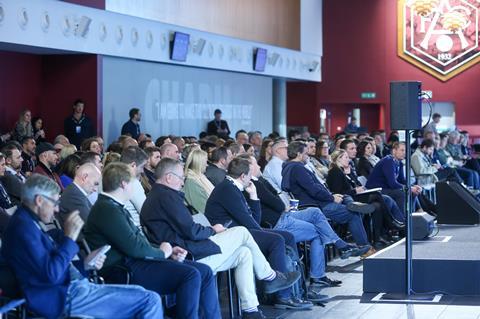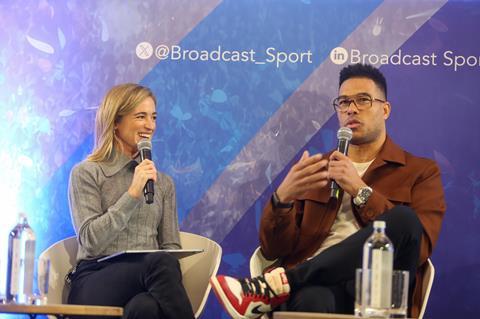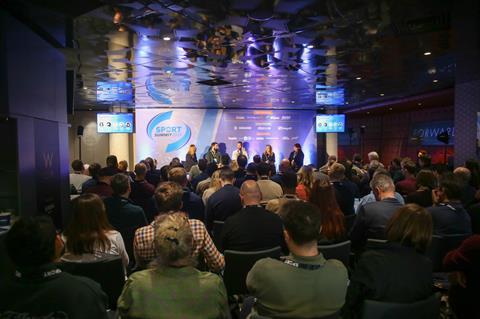The Summit takes place at Emirates Stadium on 12 November, with tickets available now

The topics and first speakers for the 2025 Broadcast Sport Summit have been revealed.
Taking place at the Emirates Stadium, London, on 12 November, the Summit will welcome over 300 attendees from across broadcast, production, rights holders, brands, tech companies, and more for a one-day, two-strand, conference with lunch and post-event networking drinks. You can buy a Super Early Bird ticket, which are limited in number, for £185 (exc VAT) here.
The 2025 Broadcast Sport Summit is sponsored by Audio Network, Emergent, Jigsaw24, M2A Media & Vizrt.
For 2025, the Summit will be examining the changing sport content environment, with topics including the rise and commercial power of women’s sport, how to produce creator-led YouTube sport entertainment formats, and whether we have hit peak sport documentary.
Production techniques will also come under the magnifying glass, with sessions on AI and automation’s effects on production and graphics, the growth in cinematic cameras and techniques in sport broadcasting, the realities of remote production, plus why podcasts are going video first - and what this means for sport on TV.

Elswhere, industry leaders will discuss the evolving distribution landscape, and how to balance between D2C platforms, linear reach, and social content to acheive the best commercial returns, and how broadcasts are being enhanced by innovations such as alternative commentary, near-live highlights, and second screen strategies.
There will also be one-to-one chats with high profile industry leaders.

Among the speakers who will be revealing their views on digital content are After Party Studios head of sport Dave Horner, Little Dot Studios managing director Robbie Spargo, LadBible head of originals Becky Gardner, and JustSo co-founder Jonny Madderson. Dan Bradley, best known from his 200,000+ follower YouTube account FPL Mate, will be giving a creator’s perspective.
Workerbee CEO Rick Murray and Filmnova creative director Lucy Cutler will be looking at the documentary environment, and other speakers include Icons Series chief content officer Chris Sice, Crowd Network talent director Louise Gwilliam, and Emergent chief business and strategy officer David Jorba.
You can read full outlines of the sessions below, and buy your ticket here.
Broadcast Sport Summit 2025 sessions
The rise and commercial power of women’s sport
This panel will look at what women’s sport should focus on to continue its growth story. Is an alternative path emerging, where it doesn’t follow in the footsteps of men’s competitions and rely on large broadcast rights deals, but instead looks to a mix of sponsorship, enhanced digital strategies and more to make its own route?
Game-changing AI and automation in production and graphics
Automation of sports productions and sports content is nothing new, with AI-driven systems having been able to handle a complete sports production for several years now. What’s different in 2025, though, is the quality of production enabled by AI. For many sports (including football, basketball, velodrome cycling hockey and more) it’s now possible for automated camera systems and AI to provide sports fans with coverage akin to human-captured footage, complete with scoreboards, branding and sports graphics.
AI can also handle the highlights production, creating personalised content for different audiences. Meanwhile, genAI is making its mark on sports content, where AI generated content is increasingly a part of the content mix for content made around branded partnerships and other short-form sports content. This panel discusses the growth of sports automation and AI in sports content and what’s next for AI in sports production.
Past the final whistle? Rethinking the future of sports documentaries
From Drive To Survive to Sunderland ‘Til I Die, the sports doc boom reshaped how audiences connect with teams, athletes, and the drama behind the scenes. But as streamers scale back, formats become more familiar, and fan fatigue creeps in – has the golden era of the sports documentary run its course?
This session asks whether we’ve hit peak doc, or if the genre is simply evolving. What does this shift mean for broadcasters, producers and sports organisations who’ve come to rely on behind-the-scenes access as a storytelling goldmine? Is the audience still there, or are they craving something fresher, more authentic, or more immersive?
The rise of cinematic sports broadcasting: Redefining the game
In today’s hyper-competitive media landscape, cinematic sports broadcasting has emerged as a transformative force reshaping how fans experience live sports. This session explores why cinematic storytelling—through enhanced camera work, dramatic visuals, immersive audio, and narrative-driven coverage—is not just a trend but a strategic response to evolving audience expectations. With younger, digital-native viewers demanding more emotion, authenticity, and immersion, leagues and broadcasters are investing in film-grade production techniques to create deeper fan engagement and cultural relevance. From Formula 1’s Drive to Survive to the NFL’s cinematic replays, we’ll examine the tools, technologies, and psychology driving this shift, and what it means for the future of sports media, monetization, and fandom.
Why sports podcasts are going video-first – and what it means for traditional TV
While video podcasts have long been part of the sport content ecosystem, recent years have seen a marked increase in the quality of production. Having moved from recorded Zoom calls to professional setups with studios and multiple cameras, will podcasts become no different to TV? Why have they taken this step, and what could it mean for factors such as the barriers to entry and the future of audio-only shows?
The big shift in sports content distribution: streamers, D2C, TV & social
The way audiences consume sport is evolving at speed and so is the way it’s commissioned, distributed, and monetised. From billion-pound streamer deals to direct-to-fan platforms and social-first storytelling, sports content is no longer confined to linear TV or even live events. This panel explores how broadcasters, streamers, producers, and rights holders are adapting to a fragmented, fast-moving ecosystem. What does the rise of D2C mean for traditional channels? How are streamers and social platforms shaping narrative formats around sport? Where does that leave filmmakers and producers navigating a space that now blends live rights, access docs, and influencer-led content? This session will offer insight into where sports content is headed, and what it takes to stay in the game.
The reality of live remote production – when it works (and when it doesn’t)
Before the pandemic, there were very few examples of large-scale remote production. Early experiments were met with awe and wonder at the technology that was making it possible. There might be a few seconds of delay in comms, but that was a small price to pay for the convenience and sustainability benefits of not having to send large numbers of crew and OB trucks to the event. The pandemic opened the floodgates for remote production with even top-tier sports getting remotely produced, with no noticeable drop in the quality of the coverage. However, there are still some sports (golf, for example) that have been slower to embrace remote production and increasing concern that sports coverage isn’t quite the same when commentators, directors, producers and even on-screen talent aren’t actually at an event. This panel debates the pros and cons of remote production, and whether there’s any turning back.
Creator-led YouTube sports entertainment formats
YouTube has become home to a huge swathe of creator-made content around sports. Alongside a plethora of specific club fan sites, there are creators that focus on fantasy leagues, freestyle football, athlete-focused entertainment content, entertaining sports challenges and so on. And then there are organised leagues and events made for YouTube, including Baller League, the Sidemen charity matches, influencer-created boxing bouts, esports competitions and more. This session investigates the growth of creator-led YouTube sports content, how it differs from traditional sport’s content, good and bad examples of it, and whether TV platforms offer anything to creators they don’t already have through YouTube, and vice versa.
Beyond live: alternative commentary, near-live highlights, social content and second screen strategies
Live sport is one of the few appointment to view experiences left in TV and streaming, but new demands for surrounding content are still being made. How can rights holders, broadcasters and production companies approach innovations such as alternative commentary from famous fans and influencers without them becoming a gimmick, and how can they create second screen experiences and social strategies that add to the live broadcast without distracting from it?








No comments yet